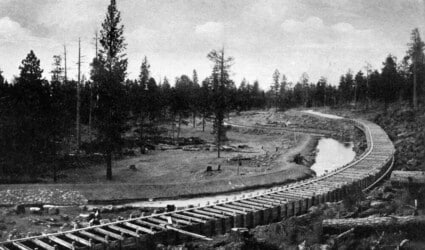This article was published on: 10/10/23 12:59 PM
The new season of the Three Sisters Historical Society’s (TSHS) Fireside Evenings will open with a presentation by Steve Lent titled “Water for a Thirsty Land – The Development of Irrigation in Central Oregon.” It will take place on Monday, October 16 at the Sisters Fire Hall, 301 S. Elm St. The presentation will be at 7 p.m. with doors opening at 6 p.m. Tickets are $10 at the door and free to TSHS members. Seating is first-come, first-served.
Lent has been the historian at the Bowman Museum in Prineville for many years and has a collection of over 5,000 historical photos. Using photos and narrative, Lent will show the development of the irrigation projects in Central Oregon and the impact it had on the land and water usage that allowed a major farming boom in the region.
The story begins in the late 1800s when Central Oregon was experiencing a large influx of homesteaders. Hundreds of enthusiastic settlers came to get their free piece of land. Unfortunately, most of the land available for settling was very arid and water was scarce. Entrepreneurs began to construct irrigation canals and a dam on the Deschutes River at Crane Prairie to store water.
Hundreds of miles of irrigation canals were constructed to distribute water to developing farmlands. Most crops grown were winter wheat and rye, until irrigation water arrived. Once water was delivered, it provided for the capability for many different crops to be grown.
Several irrigation companies began operations, including Central Oregon, Pilot Butte, Arnold, Tumalo, and Squaw Creek irrigation districts. An ill-fated project west of Tumalo was taken over by the state, but became a big disappointment. Later projects included the Ochoco Irrigation District and the North Unit Irrigation District.
There are many competing users of water today. Ongoing drought has resulted in a reduction of the once-abundant water in the region and an exploding population has led to water-use conflicts.




